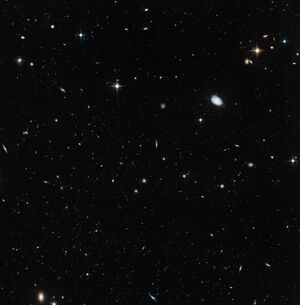Astronomy:Leo IV (dwarf galaxy)
| Leo IV Dwarf Galaxy[1] | |
|---|---|
 View of the sparse stars of Leo IV, hardly distinguishable from the background.[2] | |
| Observation data (J2000 epoch) | |
| Constellation | Leo |
| Right ascension | 11h 32m 57s[1] |
| Declination | −00° 32′ 00″[1] |
| Distance | 520+49 −45 kly (160+15 −14 kpc)[3] 154±4 kpc[4] |
| Apparent magnitude (V) | 15.9±0.5[3] |
| Characteristics | |
| Type | dSph[3] |
| Apparent size (V) | 5.7′[4] |
| Other designations | |
| Leo IV,[1] PGC 4713561 | |
Leo IV is a dwarf spheroidal galaxy situated in the Leo constellation, discovered in 2006 in the data obtained by the Sloan Digital Sky Survey.[3] The galaxy is located at the distance of about 160 kpc from the Sun and moves away from the Sun with the velocity of about 130 km/s.[3][5] It is classified as a dwarf spheroidal galaxy (dSph) meaning that it has an approximately round shape with the half-light radius of about 130 pc.[4][note 1]
Leo IV is one of the smallest and faintest satellites of the Milky Way; its integrated luminosity is about 15000 times that of the Sun (absolute visible magnitude of −5.5±0.3), which is much lower than the luminosity of a typical globular cluster.[4] However, its mass is about 1.5 million solar masses, which means that Leo's mass to light ratio is around 150. A high mass to light ratio implies that Leo IV is dominated by the dark matter.[5]
The stellar population of Leo IV consists mainly of old stars formed more than 12 billion years ago.[4] The metallicity of these old stars is also very low at [Fe/H] ≈ −2.58 ± 0.75, which means that they contain 400 times less heavy elements than the Sun.[6] The observed stars were primarily red giants, although a number of Horizontal branch stars including three RR Lyrae variable stars were also discovered.[4][note 2] The stars of Leo IV were probably among the first stars to form in the Universe. Nevertheless, the detailed study of the stellar population revealed the presence of a small number of much younger stars with the age of about 2 billion years or less. This discovery points to a complicated star formation history of this galaxy.[4] Currently there is no star formation in Leo IV. The measurements have so far failed to detect any neutral hydrogen in it—the upper limit is just 600 solar masses.[7]
In 2008, another galaxy called Leo V was discovered in the vicinity of Leo IV. The former is located 20 kpc further from the Milky Way than the latter and 3 degrees (~ 10 kpc) away from it. These two galaxies may be physically associated with each other.[8]
Notes
References
- ↑ 1.0 1.1 1.2 1.3 "NAME Leo IV Dwarf Galaxy". SIMBAD. Centre de données astronomiques de Strasbourg. http://simbad.u-strasbg.fr/simbad/sim-basic?Ident=NAME+Leo+IV+Dwarf+Galaxy.
- ↑ "Hubble Unmasks Ghost Galaxies". ESA/Hubble Press Release. http://www.spacetelescope.org/news/heic1211/.
- ↑ 3.0 3.1 3.2 3.3 3.4 3.5 Belokurov, V.; Zucker, D. B.; Evans, N. W.; Kleyna, J. T.; Koposov, S.; Hodgkin, S. T.; Irwin, M. J.; Gilmore, G. et al. (2007). "Cats and Dogs, Hair and a Hero: A Quintet of New Milky Way Companions". The Astrophysical Journal 654 (2): 897–906. doi:10.1086/509718. Bibcode: 2007ApJ...654..897B.
- ↑ 4.0 4.1 4.2 4.3 4.4 4.5 4.6 4.7 Sand, David J. et al. (2010). "A Deeper Look at Leo IV: Star Formation History and Extended Structure". The Astrophysical Journal 718 (1): 530–42. doi:10.1088/0004-637X/718/1/530. Bibcode: 2010ApJ...718..530S.
- ↑ 5.0 5.1 Simon, J. D.; Geha, M. (2007). "The Kinematics of the Ultra-faint Milky Way Satellites: Solving the Missing Satellite Problem". The Astrophysical Journal 670 (1): 313–331. doi:10.1086/521816. Bibcode: 2007ApJ...670..313S.
- ↑ Kirby, E. N.; Simon, J. D.; Geha, M.; Guhathakurta, P.; Frebel, A. (2008). "Uncovering Extremely Metal-Poor Stars in the Milky Way's Ultrafaint Dwarf Spheroidal Satellite Galaxies". The Astrophysical Journal 685 (1): L43–L46. doi:10.1086/592432. Bibcode: 2008ApJ...685L..43K.
- ↑ Grcevich, J.; Putman, M. E. (2009). "H I in Local Group Dwarf Galaxies and Stripping by the Galactic Halo". The Astrophysical Journal 696 (1): 385–395. doi:10.1088/0004-637X/696/1/385. Bibcode: 2009ApJ...696..385G.
- ↑ Belokurov, V. et al. (2008). "Leo V: A companion of a companion of the Milky Way galaxy". The Astrophysical Journal 686 (2): L83–L86. doi:10.1086/592962. Bibcode: 2008ApJ...686L..83B.
 |


